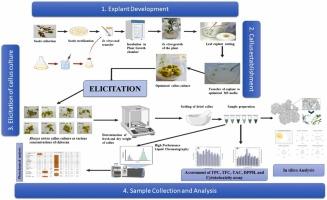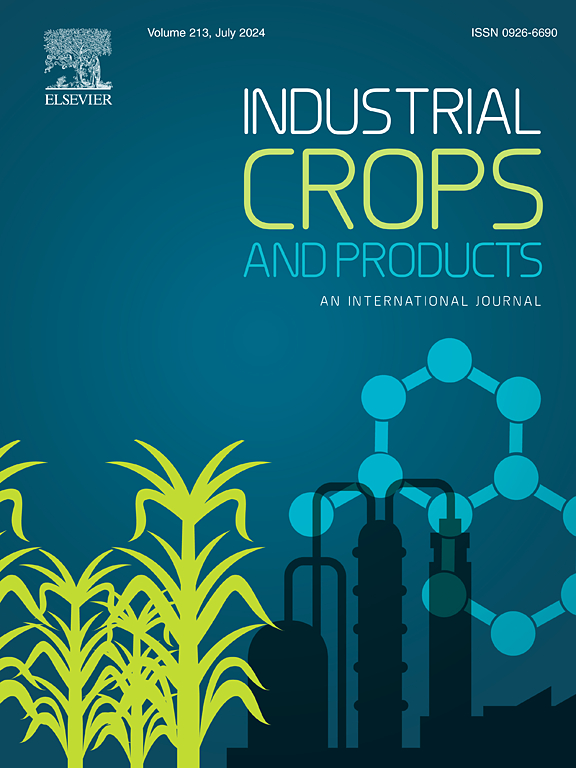Chitosan-mediated elicitation of secondary metabolism in Rhazya stricta and the in-silico exploration of phytochemicals as potential drug candidates against H1299-NSLC cell lines
IF 5.6
1区 农林科学
Q1 AGRICULTURAL ENGINEERING
引用次数: 0
Abstract
Rhazya stricta is a medicinally important plant known for its diverse pharmaceutical benefits, particularly in biosynthesizing anticancer and anti-inflammatory metabolites. For the eco-friendly and sustainable synthesis of phytochemicals and plant biomass, a biotechnological technique, ‘elicitation,’ is highly effective in various in vitro cultures. This study investigated the use of different concentrations of chitosan as a biotic elicitor in callus cultures of R. stricta, aiming to enhance biomass production, biological activities, and secondary metabolism. The findings demonstrated that maximum biomass production (FW: 40.91 ± 1.65 g/L; DW: 3.53 ± 0.11 g/L) was observed at 5 mg/L of chitosan as compared to the control. Secondary metabolites showed immense production [Phenolic content (14.50 ± 0.14 µg/mg; Flavonoid content (17.73 ± 0.80 µg/mg)] in callus cultures treated with 5 mg/L of chitosan as compared with control. Additionally, at a chitosan concentration of 1 mg/L, the elicited callus cultures had the maximum antioxidant capacity as measured by a phosphomolybdenum-based assay and DPPH free radical scavenging assay, with values of 131.82 1.53 µg/mg TAC and 94.6 % of DPPH inhibition. Callus extracts treated with 2 μg/mL of chitosan for 15 days significantly decreased the viability of H1299 cells to 60.52 %, showcasing the ability of chitosan to promote the cytotoxicity of plant extracts. In contrast to the control, cultures with chitosan concentrations of 5 mg/L revealed a considerable accumulation of pharmacologically active components, with 14 out of 19 alkaloids being the most accumulated compounds, as determined by LC-HRMS/MS analyses. Among the identified compounds, Eburnamine emerges as the most viable drug candidate that can be further screened against non-small cell lung cancer. This study highlights the potential of chitosan in augmenting the secondary metabolism of R. stricta callus cultures and provides insight into the cytotoxic potential of extracted phytochemicals, which could enhance the anticancer potential of pharmaceuticals.

壳聚糖介导的Rhazya stricta次生代谢的诱导以及植物化学物质作为H1299-NSLC细胞系潜在候选药物的计算机探索
Rhazya stricta 是一种重要的药用植物,因其多种多样的医药功效而闻名,尤其是在生物合成抗癌和抗炎代谢物方面。为了以生态友好和可持续的方式合成植物化学物质和植物生物质,生物技术 "诱导 "在各种体外培养中都非常有效。本研究调查了不同浓度的壳聚糖作为生物诱导剂在狭叶红豆杉胼胝体培养中的使用情况,旨在提高生物量生产、生物活性和次生代谢。研究结果表明,与对照组相比,壳聚糖浓度为 5 mg/L 时,生物量产量最高(FW:40.91 ± 1.65 g/L;DW:3.53 ± 0.11 g/L)。与对照组相比,5 毫克/升壳聚糖处理的胼胝体培养物中次生代谢物的产量巨大[酚含量(14.50 ± 0.14 µg/mg);类黄酮含量(17.73 ± 0.80 µg/mg)]。此外,在壳聚糖浓度为 1 毫克/升时,经磷钼测定法和 DPPH 自由基清除法测定,诱导的胼胝体培养物的抗氧化能力最强,TAC 值为 131.82 1.53 µg/mg ,DPPH 抑制率为 94.6%。用 2 μg/mL 壳聚糖处理胼胝体提取物 15 天后,H1299 细胞的存活率明显降低至 60.52%,这表明壳聚糖具有促进植物提取物细胞毒性的能力。经 LC-HRMS/MS 分析,与对照组相比,壳聚糖浓度为 5 mg/L 的培养物显示出大量药理活性成分的积累,19 种生物碱中有 14 种是积累最多的化合物。在已鉴定的化合物中,Eburnamine 是最可行的候选药物,可进一步筛选用于治疗非小细胞肺癌。这项研究强调了壳聚糖在增强严格意义上的红豆杉胼胝体培养物的次生代谢方面的潜力,并深入探讨了提取的植物化学物质的细胞毒性潜力,从而提高了药物的抗癌潜力。
本文章由计算机程序翻译,如有差异,请以英文原文为准。
求助全文
约1分钟内获得全文
求助全文
来源期刊

Industrial Crops and Products
农林科学-农业工程
CiteScore
9.50
自引率
8.50%
发文量
1518
审稿时长
43 days
期刊介绍:
Industrial Crops and Products is an International Journal publishing academic and industrial research on industrial (defined as non-food/non-feed) crops and products. Papers concern both crop-oriented and bio-based materials from crops-oriented research, and should be of interest to an international audience, hypothesis driven, and where comparisons are made statistics performed.
 求助内容:
求助内容: 应助结果提醒方式:
应助结果提醒方式:


